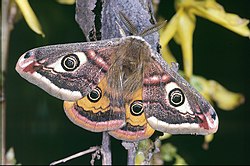Symmetry (biology)
Symmetry in biology is about the overall shape of the body and its parts. The body plans of most multicellular organisms have some form of symmetry, radial symmetry, bilateral symmetry or spherical symmetry. A few have no symmetry, and are asymmetric.
In nature and biology, symmetry is approximate. For example, plant leaves, which are more or less symmetrical, will rarely match up exactly when folded in half.
Types of symmetry
There are three basic forms:
- Radial symmetry: The organism looks like a pie. This pie can be cut up into roughly identical pieces.
- Bilateral symmetry: There is an axis; on both sides of the axis the organism looks roughly the same.
- Spherical symmetry: If the organism is cut through its center, the resulting parts look the same.
In nature and biology, symmetry is approximate. For example, plant leaves, while considered symmetric, will rarely match up exactly when folded in half.
Gallery
The patterns on the wings of butterflies are an example of bilateral symmetry
This cephalopod from plankton has bilateral symmetry
A starfish has radial symmetry, sometimes known as "rotational symmetry"
Slime mold is asymmetric
Symmetry (biology) Media
Illustration depicting the difference between bilateral (Drosophila), radial (actinomorphic flowers) and spherical (coccus bacteria) symmetry
Lilium bulbiferum displays hexamerism with repeated parts arranged around the axis of the flower.
Gastroenteritis viruses have icosahedral symmetry.
The small emperor moth, Saturnia pavonia, displays a deimatic pattern with bilateral symmetry.
Flower of bee orchid (Ophrys apifera) is bilaterally symmetrical (zygomorphic). The lip of the flower resembles the (bilaterally symmetric) abdomen of a female bee; pollination occurs when a male bee attempts to mate with it.
The Ediacaran phylum Trilobozoa possess a wide variety of body shapes, mostly tri-radial symmetry, although their most famous member, Tribrachidium, possesses a triskelion body shape.













